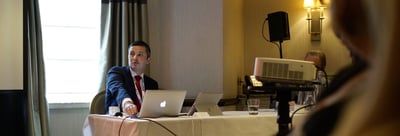Could data be key to solving the global slavery crisis?
Lead author and editor of the UN’s Data Revolution report, Dr. Claire Melamed, noted that just 15% of malaria deaths and 16% of all births recorded globally are from actual reported numbers. This is surprising, as you would expect that something like births and deaths to be simple to count. The difficulty in finding an accurate figure paints the perfect picture of just how challenging it is to estimate something as hidden and complex as modern slavery. Nonetheless that is exactly what many organisations and institutions have attempted to do, and all have ended up with vastly different estimates of the number of people who are victims of this crime globally.
I won’t delve into a comparison between these estimates and the contentions they have garnered thanks to the differences in definitions and scope. Nor will I detail the reasons their methodologies have been challenged. What I instead intend to do is question whether such broad, global estimates – after all, they’re “guesstimates” for a reason – are even worth looking at when it comes to the fight against modern slavery. For clarity, I choose the broad term of modern slavery in this context as I think it best to stay consistent with UK legislation and current jargon.
We need the right kind of visibility
Without a doubt, these guesstimates help generate media attention, which can lead to increased awareness and funding for the fight against modern slavery. However, for international organisations and businesses, such broad-brush numbers provide nothing more than a miscalculated and misleading picture of how, where and in what numbers modern slavery operates in the world.
Bad data means bad decisions
 Without reliable data about the types of slavery, within what demographics and in what localities, businesses are left developing global overarching strategies based on inaccurate information that may not even be effective on the ground. As Human Rights expert and specialist in human trafficking, Anne Gallagher, says: “The most immediate problem is that poor information, presented as fact, contributes to poor decision making and sometimes highly damaging, unintended outcomes”. This sentiment is echoed by many other experts in the field. Beyond this, businesses have little reliable data to evaluate the success, failure, or consequences of their strategies to reduce slavery in a targeted area.
Without reliable data about the types of slavery, within what demographics and in what localities, businesses are left developing global overarching strategies based on inaccurate information that may not even be effective on the ground. As Human Rights expert and specialist in human trafficking, Anne Gallagher, says: “The most immediate problem is that poor information, presented as fact, contributes to poor decision making and sometimes highly damaging, unintended outcomes”. This sentiment is echoed by many other experts in the field. Beyond this, businesses have little reliable data to evaluate the success, failure, or consequences of their strategies to reduce slavery in a targeted area.
The data is limited
We need to be brutally honest about the present limitations that exist in our data on modern slavery. Instead of looking for grand global figures, we must look at how businesses together with NGOs, governments and international institutions can contribute to much more granular research. This will help us to increase our understanding of the prominence and specifics of modern slavery, and how this links to businesses’ supply chains.
Use localised data for more value
It’s true that localised research may not lead to shocking statistics that can mobilise the public and politicians alike. But rather than an anti-slavery strategy based on information that is lacking at best and misleading at worst, it is more effective for a business to attain local knowledge of any modern slavery that exists within the specific parts of their supply chain. Businesses will not only then be better equipped to develop effective measures to reduce modern slavery, they will also be able to demonstrate their success stories by measuring reductions of modern slavery in their targeted areas.
Use data to demonstrate success
 Success stories such as this will be vital for companies in showing how they year-on-year are reducing the risk of modern slavery in their supply chains and business operations. We at Segura have worked with brands in releasing their initial Modern Slavery Statements. Looking to the future, we hope brands, NGOs and governmental institutions will develop stronger research ties so that brands can gain a 360˚ view of their supply chains. Only then can brands implement effective strategies and measure their success at reducing the number of modern slaves in the world.
Success stories such as this will be vital for companies in showing how they year-on-year are reducing the risk of modern slavery in their supply chains and business operations. We at Segura have worked with brands in releasing their initial Modern Slavery Statements. Looking to the future, we hope brands, NGOs and governmental institutions will develop stronger research ties so that brands can gain a 360˚ view of their supply chains. Only then can brands implement effective strategies and measure their success at reducing the number of modern slaves in the world.
Original Publish Date 24/1/2017
Further readings:
Proper Methodology and Methods of Collecting and Analyzing Slavery Data: An Examination of the Global Slavery Index by Andrew Guth, Robyn Anderson, Kasey Kinnard and Hang Tran in Social Inclusion 2014, Vol. 2, Issue 4, pages 14-22
http://traccc.gmu.edu/wp-content/uploads/2014/11/Methodology-in-Trafficking.pdf
Assessing the Extent of Human Trafficking: Inherent Difficulties and Gradual Progress by Dianne Scullion in Social Inclusion 2015, Vol. 3, Issue 1, pages 22-34
http://www.cogitatiopress.com/ojs/index.php/socialinclusion/article/view/176
Describing the Unobserved: Methodological Challenges in Empirical Studies on Human Trafficking by Guri Tyldum and Anette Brunovskis in International Migration 2005, Vol. 43 (1/2), pages 17-34
http://onlinelibrary.wiley.com/doi/10.1111/j.0020-7985.2005.00310.x/abstract
Tip of the Iceberg? Improving the Interpretation and Presentation of Trafficking Data by Dr. Dita Vogel in International Centre for Migration Policy Development (Policy Brief)
http://lastradainternational.org/lsidocs/3043THB_Data_Policy_Brief_March_2014_web.pdf
Inaccurate Numbers, Inadequate Policies Enhancing Data to Evaluate the Prevalence of Human Trafficking in ASEAN by Jessie Brunner, publication by East-West Centre, 2015

